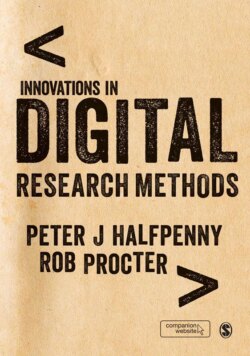Читать книгу Innovations in Digital Research Methods - Группа авторов - Страница 30
На сайте Литреса книга снята с продажи.
1.4.2 The Data Deluge
ОглавлениеAs reiterated in most of the chapters in this volume, we live in an information age characterized by a deluge of digital data (Hey and Trefethen, 2004; Hey, Tansley and Tolle, 2009). The chapters set out many of the potential research benefits to be obtained by collecting and analysing artificially produced and naturally occurring big data of many kinds from numerous sources. However, these benefits will only be realized if the wealth of data is managed in ways that ensure that it is discoverable, accessible, usable and re-usable. Indeed, research data management was a cornerstone of the original e-Research vision.
Accordingly, national e-Research programmes to innovate research methods, tools and infrastructure have devoted significant efforts to raise awareness among stakeholders that research data is a vital resource whose value needs to be preserved for future research by the data originators and by others. Achieving this requires that the data be systematically organized, securely stored, fully described, easily locatable, accessible on appropriate authority, shareable, archived and curated. Fulfilling all of these research data management tasks is a complex socio-technical challenge that stakeholders, whether they are research funders, higher education institutions (HEIs), publishers, researchers or regulators, are currently ill prepared to meet (Procter, Halfpenny and Voss, 2012). There are, as yet, no widely-agreed, mature solutions that can be implemented across all the various platforms that researchers use. Moreover, given the combination of the data deluge and a world recession, the scale of the tasks is increasing while the financial and therefore human resources to undertake the tasks are shrinking.
Ensuring the implementation and sustainability of data preservation will need to take on board the prospect of research becoming more collaborative and research teams being more widely distributed, as signalled in the e-Research vision of researchers world-wide addressing key challenges in new ways. The implications for data management services are summarized in a report from the Department for Business, Innovation and Skills (BIS) in the UK, which concluded, ‘A federated infrastructure will be essential to exploit existing and future investments [in data] effectively’ (Business, Innovation and Skills, 2010, 9). If such a federated infrastructure is to be achievable, then establishing effective inter-institutional service models will take on increasing importance. HEIs and other research organizations will need to develop strategies and infrastructure solutions that enable the federation of individual data repositories and the virtualization of data services. This will add a further layer of sustainability issues, the opportunities, costs and benefits of such collaborations will need to be carefully examined, and HEIs (both large and small) will need to develop competencies in managing services that span administrative and funding boundaries. In the current competitive environment, with universities locked in a zero-sum struggle for resources, there is little incentive to put effort into the inter-institutional cooperation required.
The term big social data serves to draw attention to three salient dimensions that define new forms of social data: volume, variety and velocity, the last reflecting its often real-time and rapidly changing character. Developments linked to the emergence of big social data are happening continually and we cannot be certain what impact such data will have on research processes. It is possible that it will promote the use of new computational social science methods in place of more traditional quantitative and qualitative research methods. It might also influence thinking and re-orientate social research around new objects, populations and techniques; network analysis offers an example here. The analysis of social processes as they actually happen is bound to give researchers insights and interesting avenues to explore that are absent from the often post-hoc reconstructions of events that are available via traditional research instruments and datasets.
Big social data will inevitably force us to rethink the role of academic social scientists. One way forward would be for them to actively seek collaborations with groups, both professional and lay, involved in doing various kinds of ‘practical, everyday sociology’. An example of collaboration with professionals might include assisting journalists8 who increasingly find themselves needing to analyse large datasets in order to report news stories.9 Examples of collaborating with lay people include ‘citizen social science’ where members of the public can assist with research through crowd-sourcing data (as illustrated in Chapter 9), by participating in analytical work (Procter et al., 2013b), and even by taking a role in the setting of research agendas (Housley et al., 2014). These examples suggest possibilities for forging a new relationship between academic social science and society at large, a ‘public sociology’ (Burawoy, 2005), where social scientific knowledge is co-produced by a wide range of stakeholders (Housley et al., 2014) and is subject to greater public oversight and accountability. Initiatives in other discipline areas might provide models for how to proceed in the social sciences: see, for example, the Public Laboratory for Open Technology and Science (http://publiclab.org/), whose ‘goal is to increase the ability of underserved communities to identify, redress, remediate, and create awareness and accountability around environmental concerns.’
Finally, as is noted in several of the chapters that follow, big social data has given fresh stimulus to debates about research ethics (see e.g., boyd and Crawford, 2012), much of which focuses on the issue of people’s right to privacy but which also raises questions about the role and status of academic research. At the same time, we must not lose sight of the broader issue of the ethics of research and innovation (see e.g. Stahl, Eden and Jirotka, 2012, and Chapter 12 in this volume).
